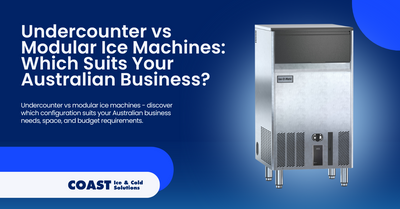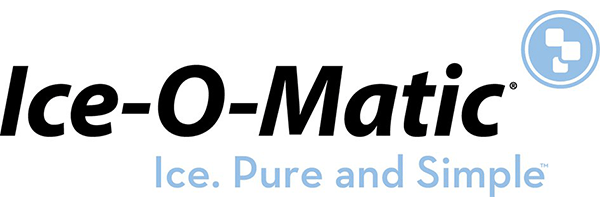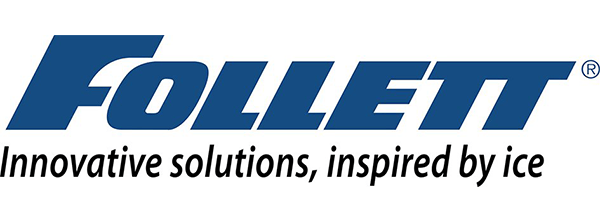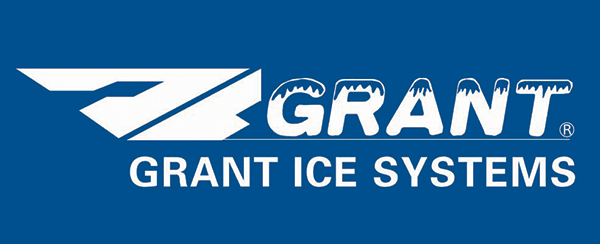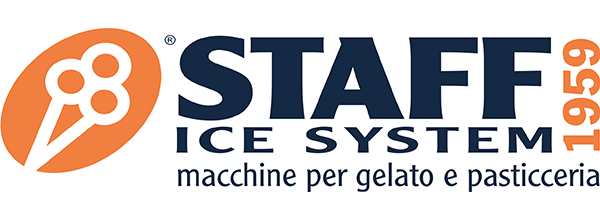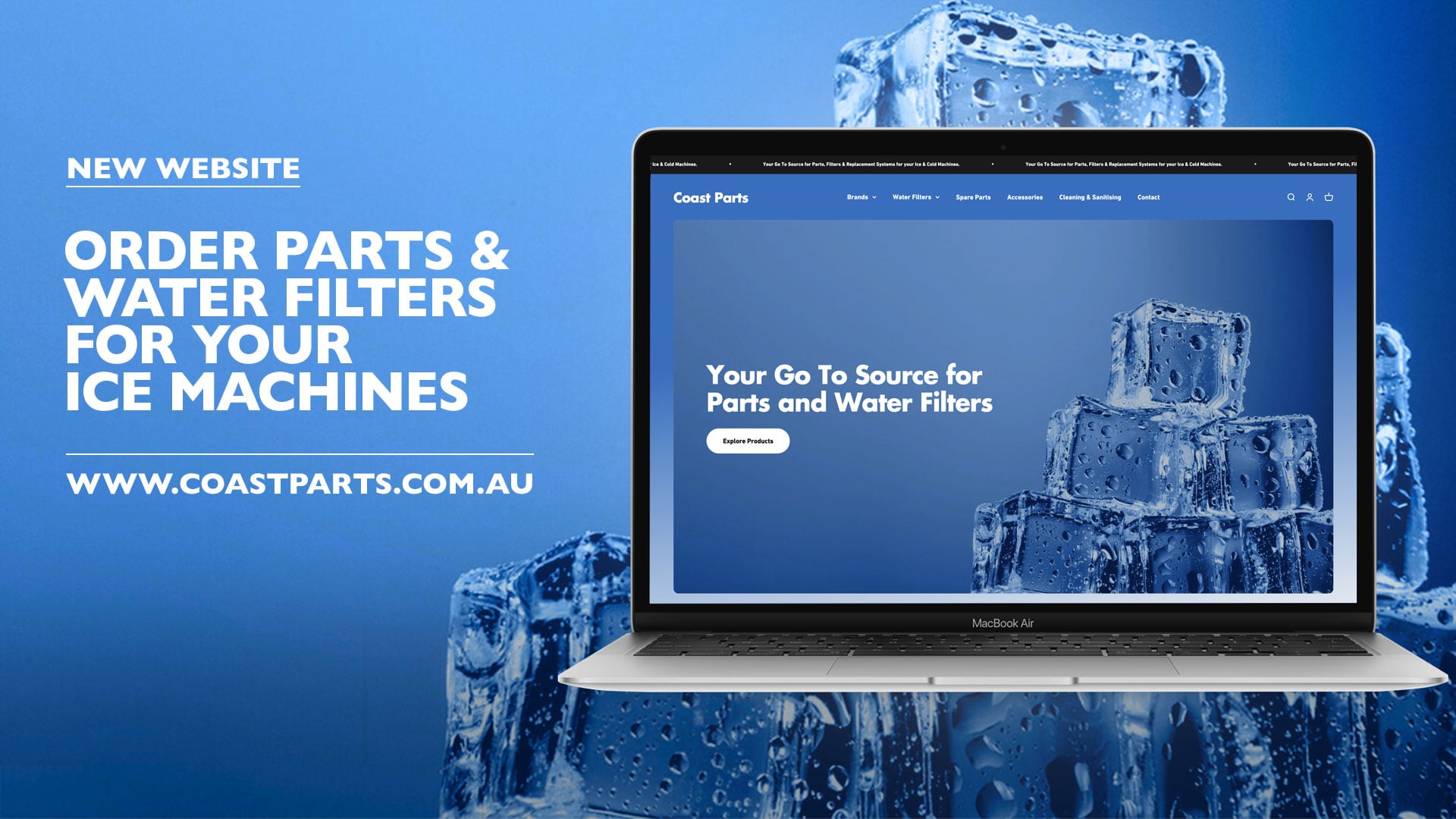Undercounter vs Modular Ice Machines: Which Suits Your Australian Business?
The Coast Team on 1st Jul 2025
You're reviewing equipment quotes for your new Melbourne café when you notice the ice machine prices range from $4,000 to $25,000. The sales rep explains that the cheaper option is an undercounter unit while the expensive one is a modular system, then launches into technical specifications about BTUs and harvest cycles. What they don't explain is why one costs six times more than the other, or more importantly, which one will actually work for your specific situation.
This scenario plays out daily across Australian businesses. The fundamental choice between undercounter and modular ice machines often gets lost in a maze of production capacities, installation requirements, and feature lists. Yet this decision will affect everything from your kitchen workflow to your electricity bills for the next decade. Understanding the real differences between these configurations – beyond just size and price – is what separates businesses that thrive from those constantly battling equipment limitations.
Understanding the Fundamental Differences
Let's cut through the marketing fluff and talk about what actually matters. Undercounter ice machines are self-contained units that combine ice production and storage in one neat package. Think of them as the Swiss Army knives of the ice world – everything you need in one compact unit that slides under your bench like it was born to live there.
Modular ice machines, on the other hand, are just the ice-making head. They're the powerhouses that sit on top of separate storage bins, ice dispensers, or even soda fountains. It's like buying a high-performance engine that you can pair with whatever chassis suits your needs.
The distinction might seem academic until you're trying to squeeze equipment into a heritage-listed Melbourne café where every square centimetre counts. Or when you're fitting out a mining camp kitchen in the Pilbara where modular flexibility means you can position noisy compressors away from dining areas while keeping ice storage exactly where crews need it.
Space Constraints and Kitchen Layout Realities
Australian commercial kitchens aren't getting any bigger, but health department requirements keep expanding. You need prep space, storage, cooking equipment, and somehow you've got to fit ice production into the mix without creating workflow bottlenecks.
Undercounter units like the Ice-O-Matic ICEU225 shine in tight spaces. At just 610mm wide and designed to fit under standard 900mm benches, they slot into spaces where nothing else would work. We've installed these in Sydney food trucks, Perth cocktail bars, and even cramped Brisbane café kitchens where the "equipment room" was more like an equipment cupboard.
But here's where people get it wrong – they think small footprint means compromise. The ICEU225 produces 96kg of cube ice daily with 32kg storage capacity. That's enough for a busy 50-seat restaurant, all from a unit that takes up less space than a commercial dishwasher.
Modular systems demand more planning but offer incredible flexibility. Take the Ice-O-Matic CIM0635 producing 265kg daily. You can mount it on a bin in your back-of-house area, run it on top of a drink dispenser at your service station, or even install it in a ventilated equipment room with the bin in your bar. The configuration options are nearly endless, but you need the ceiling height and floor space to accommodate both components.
Production Capacity: Getting the Numbers Right
Nothing kills service faster than running out of ice during a 40-degree Saturday night. But oversizing wastes money, energy, and valuable space. Finding the sweet spot requires honest assessment of your actual needs, not optimistic guesses.
Undercounter units typically produce between 20kg and 150kg daily. The Ice-O-Matic UCG165A sits at the upper end, producing 69kg of gourmet ice perfect for premium spirits in upscale establishments. That might sound modest compared to modular units, but remember – production happens 24/7 while usage comes in bursts. With 40kg storage capacity, you've got enough for cocktail bars and hotel lounges serving premium drinks.
Modular ice machines scale from around 130kg to over 1000kg daily production. The Ice-O-Matic CIM1135 churns out 425kg every 24 hours – enough for a large hotel or busy waterfront restaurant. But here's the catch: you need appropriate bin capacity to store all that ice. Pairing a high-production head with an undersized bin means you're literally melting money down the drain.
We always recommend calculating based on your busiest possible day, then adding 20% buffer. That McLaren Vale winery might cruise along using 50kg daily, but when bus tours arrive, consumption can triple. Better to have capacity you occasionally don't need than to scramble for emergency bagged ice at premium prices.
Installation Complexity and Hidden Costs
Here's where the real world intrudes on equipment dreams. That bargain modular system suddenly doesn't look so affordable when you factor in installation realities.
Undercounter units typically install like any other kitchen appliance. The Ice-O-Matic ICEU225 needs a standard 10-amp power outlet, cold water connection, and floor drain. Most qualified plumbers can knock out the installation in a few hours. Budget $800-1,500 for typical installations in metro areas, maybe double that for regional locations.
Modular installations get complex fast. First, you need to ensure your floor can handle the weight – a full 850kg capacity bin weighs over a tonne when loaded. Many older buildings require structural assessment and potential reinforcement. Then there's the electrical side. Larger units like the Ice-O-Matic CIM1135 often require three-phase power. If your building doesn't have it, you're looking at $3,000-8,000 for electrical upgrades.
Don't forget about bin door clearance either. That bin needs space to open for scooping ice, and we've seen too many installations where someone measured the footprint but forgot about operational space. Remote installations add another layer – you need refrigeration lines running between the head and condenser, which means cutting through walls and ceilings.
Energy Efficiency and Operating Costs
Your ice machine will run virtually non-stop for the next decade. Small efficiency differences compound into serious money over that timeframe.
Modern undercounter units have gotten remarkably efficient. The Ice-O-Matic UCG065A gourmet ice maker uses about 5.5kWh to produce 30kg of crystal-clear ice. At Queensland commercial electricity rates around $0.30/kWh, that's roughly $1.65 per 30kg. Perfect for establishments where presentation justifies premium pricing.
Modular units benefit from economies of scale. The Ice-O-Matic CIM0635 produces ice at about 4.8kWh per 45kg – noticeably more efficient per kilogram. Over a year of heavy use, that efficiency gap could save $1,000-2,000 in electricity costs.
But efficiency isn't just about energy consumption. Water usage matters too, especially with increasing drought concerns across Australia. Look for units with water-saving features and consider the CD20B filtration system to reduce water waste from purge cycles. Every litre saved helps both your bottom line and environmental credentials.
Maintenance Access and Service Considerations
Ice machines need regular love to keep performing. How easy that maintenance is depends largely on your configuration choice.
Undercounter units excel in accessibility. Pull the unit out on its legs or castors, and every component is reachable. Daily cleaning of the Ice-O-Matic ICEU225 takes minutes – wipe down the exterior, check the air filter, ensure the bin is clean. Even major service work happens at comfortable working height.
Modular systems can be maintenance nightmares if poorly positioned. Ice machine heads mounted on tall bins put technicians on ladders for routine service. Units crammed into corners make filter changes a contortionist act. We've seen installations where accessing the water filter required moving three other pieces of equipment – guess how often those filters got changed?
Smart operators plan maintenance access from day one. That means removable panels stay clear, service valves remain accessible, and there's room to work without shutting down half your kitchen. The CD40B twin filtration system includes bypass valves specifically so you can change filters without interrupting ice production.
Noise Levels and Customer Experience
Nobody talks about ice machine noise until it's driving customers away from your intimate dining room. Compressor noise, harvest cycles, and bin door slamming all contribute to the acoustic landscape of your business.
Undercounter units put the compressor right where you're working. Quality units like the Ice-O-Matic ICEU225 use sound dampening technology, but you'll still hear them cycle. In open kitchens or bar installations where customers sit nearby, this matters. We've retrofitted countless installations with sound barriers after complaints started rolling in.
Modular systems offer acoustic flexibility. Install the ice-making head in a back room or basement, run insulated lines to your bin, and customers never hear a thing. Hotels particularly love this approach – nobody wants compressor noise at 2 AM when the penthouse suite is trying to sleep.
The harvest cycle creates its own challenges. When 20kg of ice drops into an empty bin, everyone knows it. Scheduling production around service times and maintaining adequate ice levels prevents those thunderous 3 AM avalanches that wake up half the neighbourhood.
Water Quality Impact on Equipment Choice
Australian water quality varies dramatically, and your choice between undercounter and modular can depend on what's coming out of your taps.
Hard water areas like Adelaide and Perth face serious scale challenges. Undercounter units have less complex water systems, making them somewhat more tolerant of mineral content. But you'll still need quality filtration like the CD10B system to prevent damage in any ice machine.
Modular systems, with their higher water flow rates and more complex distribution systems, suffer more from poor water quality. Scale buildup in a Ice-O-Matic CIM1135 doesn't just reduce efficiency – it can cause catastrophic failures. We've pulled distribution tubes so clogged with scale they looked like coral formations.
Regional areas face additional challenges. Bore water often contains iron and other minerals that standard filtration can't handle. Seasonal variations mean what works in winter might fail when summer storms stir up sediment. Choosing simpler undercounter units often makes sense where water quality remains unpredictable.
Special Applications and Industry-Specific Needs
Different industries gravitate toward different configurations for good reasons.
Healthcare facilities almost universally prefer specialised dispensers like the Follett 7 & 15 Series for their touchless operation and Chewblet ice that's safe for patients with swallowing difficulties. The self-contained design minimises contamination points – when every surface needs regular sanitisation, simpler is safer.
High-volume bars and restaurants lean heavily toward modular systems. The ability to position multiple bins fed by a single high-capacity head like the Ice-O-Matic CIM0635 means staff never run dry during peak service. For supplementary ice needs, the Ice-O-Matic MFI1255A modular flake ice maker provides 572kg daily production.
Seafood retailers need specific ice types that influence configuration choices. The Grant FF-AR Series produces sub-zero flake ice at -9°C – essential for maintaining seafood quality. These industrial-grade systems offer capacities from 400kg to 5,000kg daily, perfect for major seafood markets.
Mobile operations and small cafés almost always choose undercounter units. Food trucks and temporary installations need plug-and-play simplicity. The compact footprint and integrated design travel well and set up quickly.
Making the Financial Decision
Let's talk real numbers. Undercounter units typically run $3,000-12,000 installed. A quality unit like the Ice-O-Matic UCG165A might cost $5,440 plus installation, but you're getting gourmet ice production perfect for premium spirits service.
Modular systems start around $8,000 for basic configurations but quickly climb. A Ice-O-Matic CIM0635 head costs one thing, but add a bin, installation, and possibly electrical upgrades, and you're looking at $15,000-25,000 total investment. High-capacity systems can push past $40,000 installed.
But purchase price tells only part of the story. Calculate total cost of ownership including energy consumption, water usage, maintenance requirements, and potential downtime. That bargain modular system consuming 30% more power costs an extra $2,000 annually to run. Over ten years, efficiency differences often exceed purchase price variations.
Consider growth plans too. Starting with an undercounter unit then upgrading to modular later means buying twice. But installing excess capacity you won't use for years wastes money on energy and maintenance. We generally recommend sizing for where you'll be in 2-3 years, not 5-10.
Future-Proofing Your Ice Equipment Investment
Technology keeps advancing, but basic refrigeration principles remain constant. When choosing between configurations, consider long-term trends affecting your decision.
Sustainability requirements keep tightening. Energy efficiency standards that seem stringent now will be minimum requirements in five years. Water restrictions during droughts may limit high-consumption units. Natural refrigerants are becoming mandatory in some applications. Choosing efficient, water-conscious equipment now avoids expensive retrofits later.
Automation and monitoring capabilities matter more each year. Modern units offer WiFi connectivity for remote monitoring, predictive maintenance alerts, and usage tracking. While these features add upfront cost, they prevent failures and optimise operations. Undercounter units increasingly include these capabilities, while modular systems have offered them longer.
Labour shortages affect maintenance and operation. Equipment requiring less frequent service and simpler operation becomes more valuable as skilled technicians become scarcer. Self-cleaning cycles, extended filter life, and diagnostic capabilities reduce dependency on increasingly expensive service calls.
Why Partner with Coast Distributors
When you're investing tens of thousands in ice equipment, you need more than just a supplier – you need a partner who understands your business realities. Coast Distributors brings over two decades of experience helping Australian businesses navigate exactly these decisions. We've seen every possible installation challenge, from heritage building restrictions in Melbourne to cyclone-proofing in Cairns.
Our approach differs because we start with your needs, not our inventory. Our team takes time to understand your operation, analyse your actual requirements, and recommend solutions based on real-world experience. We'll tell you honestly when an undercounter unit makes sense and when you really need modular capacity. This transparency has built our reputation as Australia's trusted ice equipment partner.
What truly sets us apart is our commitment to your success beyond the sale. Our 24-hour service support means when equipment issues threaten your operation, help is always available. Our comprehensive spare parts inventory ensures minimal downtime. And our technicians actually understand hospitality and commercial operations – they're solving business problems, not just fixing machines.
Ready to find the perfect ice solution for your business? Visit our contact form and let our expert team create a personalised recommendation based on your specific needs. With Coast Distributors, you're not just buying equipment – you're investing in a partnership that ensures your ice systems support your business growth for years to come.
Ready to choose the perfect ice machine configuration for your Australian business?
Contact Coast Distributors to discuss which ice machine type suits your operational needs:
- View the Ice-O-Matic ICEU225 undercounter specifications
- View the Ice-O-Matic CIM0635 modular specifications
- Explore our complete range of commercial ice machines
- Speak with our expert team by filling out our contact form
- Need a service for your machine: fill out our service request form
- Need water filters or spare parts? Browse our parts inventory
Don't let choosing the wrong ice machine configuration compromise your operational efficiency. Join the growing number of Australian businesses already benefiting from properly specified ice equipment.
Coast Distributors is Australia's exclusive Ice-O-Matic, Follett and Grant distributor, providing commercial ice solutions nationwide. With 24-hour service support and extensive industry experience, we ensure your ice equipment supports optimal business performance. Visit coastdistributors.com.au to learn more.

